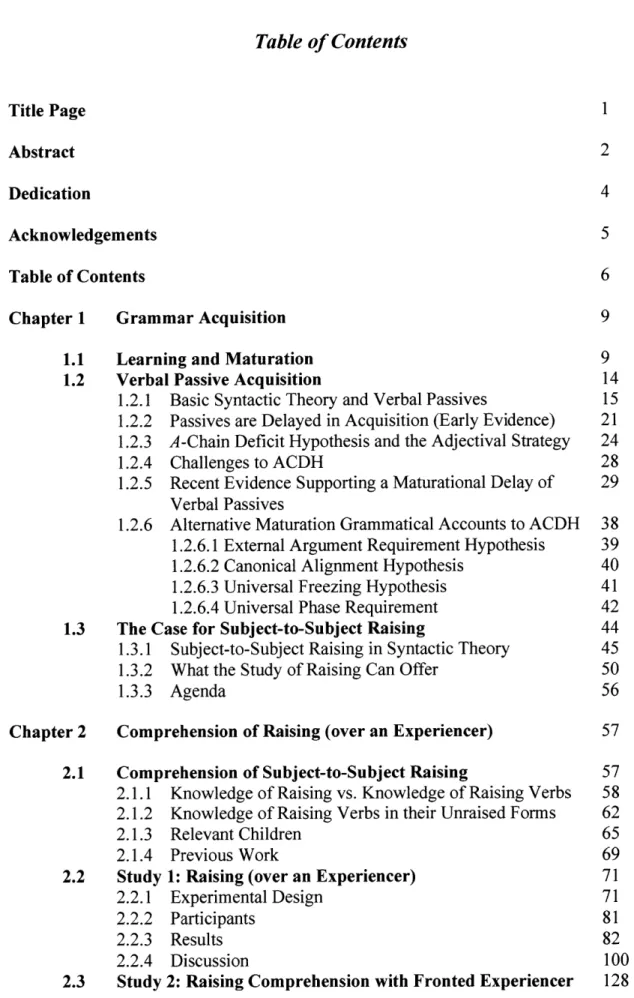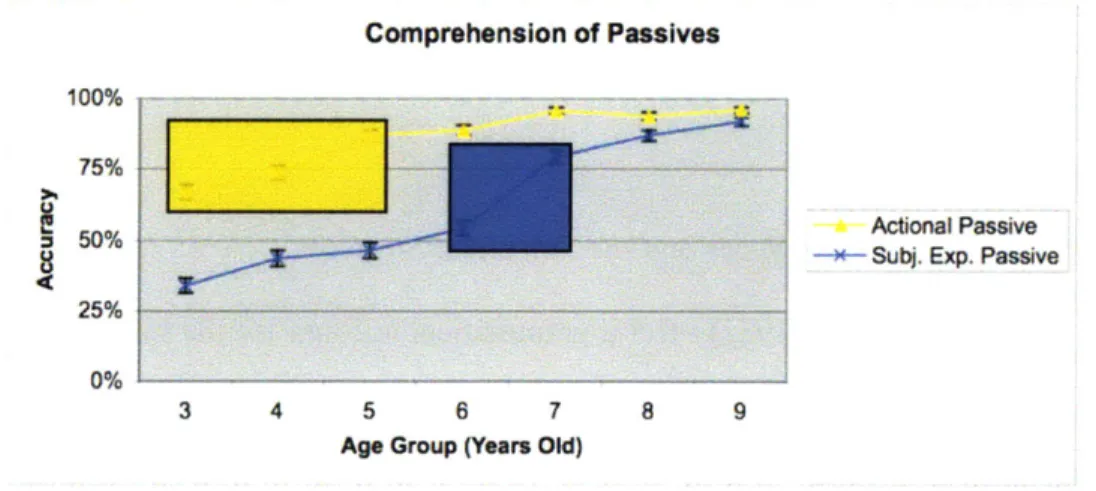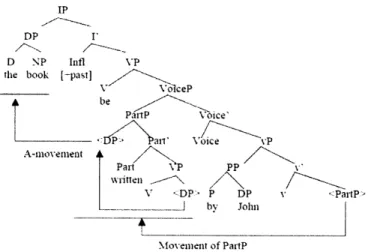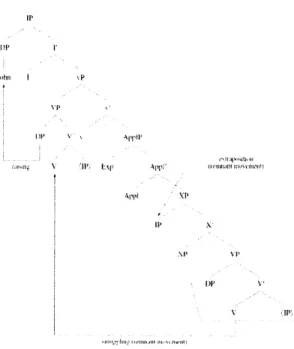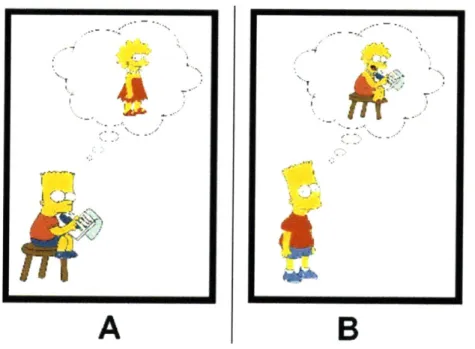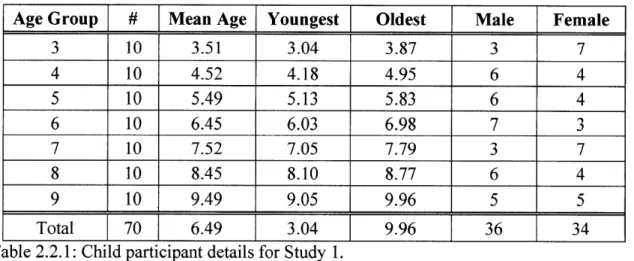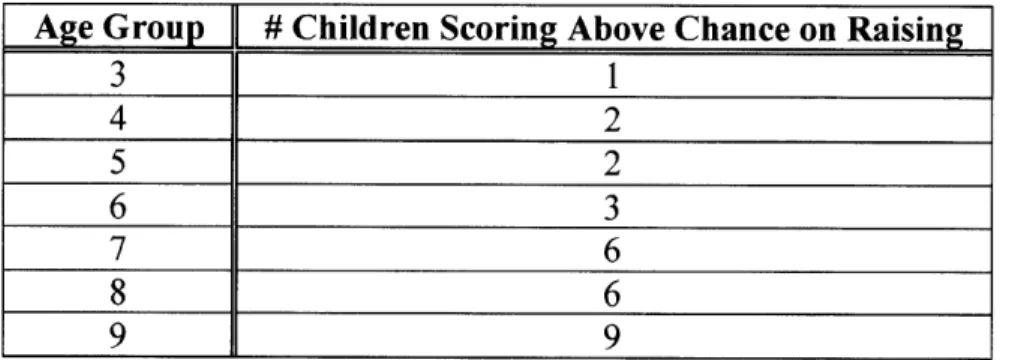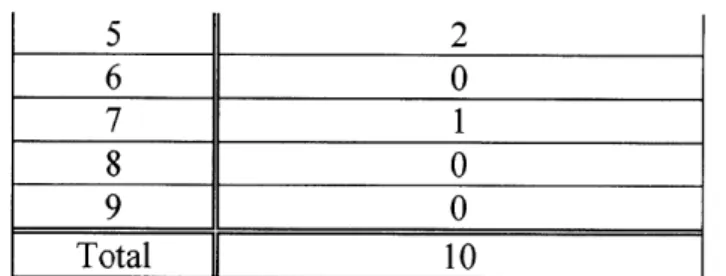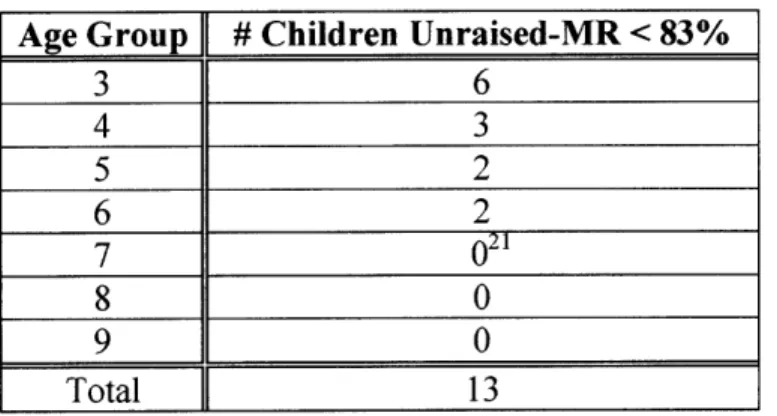The Acquisition of Raising
by
Christopher K. Hirsch B.A. Cognitive Science
B.A. Linguistics
University of California, Berkeley 2002 MASSACHUSETTS INSTITUTE
OF TECHNEOLOy
FEB 0 9 20111
LIBRARIES
ARCHNES
SUBMITTED TO THE DEPARTMENT OF COGNITIVE SCIENCES IN PARTIAL FULFILLMENT OF THE REQUIREMENTS FOR THE DEGREE OF
DOCTOR OF PHILOSOPHY IN COGNITIVE SCIENCES
AT THE
MASSACHUSETTS INSTITUTE OF TECHNOLOGY
FEBRUARY 2011
C 2011 Christopher K. Hirsch. All rights reserved.
The author hereby grants to MIT permission to reproduce and to distribute publicly paper and electronic copies of this thesis document in whole or in part in any medium now
known or hereafter created.
Signature of Author:
Certified by:
Department of Brain and Cognitive Sciences
October 27, 2010
/,
2
&ennetn N. Wexler, Ph.D. Professor of Psychology and Linguistics Thesis Supervisor
Accepted by:
Earl K. Miller, Ph.D. Picower Professor of Neuroscience Director, BCS Graduate Program zl
The Acquisition of Raising
byChristopher K. Hirsch
Submitted to the Department of Brain and Cognitive Sciences on October 27*, 2010 in Partial Fulfillment of the Requirements for the Degree of Doctor of Philosophy in
Cognitive Sciences
Abstract
This work serves as the first comprehensive investigation into typically developing children's acquisition of subject-to-subject (StS) raising. In particular, it asks how English-speaking children come to comprehend a StS raised sentence like (1) versus its semantically equivalent unraised counterpart (2), and how the presence of an experiencer-phrase affects interpretation (3):
(1) Johni seems [ti to be dancing]. (2) It seems that John is dancing.
(3) Johni seems to Mary [ti to be dancing].
The acquisition of StS raising is of particular bearing given renewed interest in the acquisition of verbal passives, which share syntactic traits with StS raising and which
have been argued to develop late under genetic guidance.
Using sentence-picture matching and truth-value judgment experiments, the following comprehension results obtain:
e Unraised sentences are acquired early, with most three-year-old children demonstrating mastery.
- Sentences involving StS raising over an experiencer (ROE) are delayed until around age seven, with many children incorrectly interpreting them as involving raising-to-object (RtO) syntax.
e Sentences involving StS raising with no experiencer (RNE) are likewise delayed until around age seven, with many children incorrectly interpreting them as involving either subject control or copular syntax.
- Subject control sentences are acquired early, by at least age three.
- The delayed acquisition of StS raising (ROE and RNE) appears to be developmentally linked with the delayed acquisition of verbal passives.
The noted delay in comprehension of StS raising occurs despite the fact that StS raising sentences are found to be relatively common in child-directed speech. These data
serve to rule out several grammatical acquisition accounts in the literature that have attempted to capture children's delayed comprehension of verbal passives (e.g. External Argument Requirement Hypothesis, Canonical Alignment Hypothesis, and Universal Freezing Hypothesis). The data, however, are both compatible with and predicted by the Universal Phase Requirement (UPR; Wexler, 2004), a grammatical account on which children are claimed to take all vPs to define strong phases for maturational reasons. Only UPR correctly predicts delay for StS raising (with and without an experiencer-phrase) in early child grammar, and a positive correlation with the acquisition of verbal passives.
ACKNOWLEDGMENTS
Immense gratitude to Ken Wexler for many years of inspiration, long talks, an open door, insight, cheerleading, and first class mentorship.
Special thanks to the rest of my committee, Shigeru Miyagawa, Irene Heim, and Laura Schultz, for insightful comments, suggestions, and critiques.
I was blessed with very loving parents, Steven Hirsch and Susanne Hirsch; early lessons learned helped drive the passion that underwrote this work. Mom also served as my (saintly) editor.
Of everyone, I am the one most thankful for finishing. My wife, Jennifer Hirsch, comes in second. A supportive spouse makes nearly anything seem possible.
Two longtime lab peers, Alexandra Perovic and Nadya Modyanova, deserve particular recognition. It is in the trenches of daily research that the strongest academic bonds are formed.
Many others along the way offered invaluable assistance: David Pesetsky, Danny Fox, Ted Gibson, Yosef Grodzinsky, Alec Marantz, Gregory Marton, Misha Becker, Nina Hyams, Carson Schntze, William Snyder, Karen Froud, Vina Tsakali, Jenny Ganger, Loes Koring, Sophia Manika, Charlotte Herzmann, and the audiences at various conferences.
Strong experimental research is made easier through a strong laboratory. I am thankful to the entire Wexler ab/Normal Language Lab, and in particular Sun Yoo, Jeremy Hartman, Karen Law, Robyn Orfitelli, and the rest of the Wexler Lab undergraduate research assistants.
Money always helps. This research was supported in part by an NSF Graduate Fellowship, and by a Marcus Fund awarded to the Department of Brain and Cognitive Sciences at MIT.
The work presented here requires participating children. I am grateful to all the parents and teachers at the various daycares for their consent, patience, and willingness to support these scientific inquiries. Most importantly, thank you to all the children who actually had to sit through and endure all these various experiments.
Table of Contents
Title Page 1 Abstract 2 Dedication 4 Acknowledgements 5 Table of Contents 6Chapter I Grammar Acquisition 9
1.1 Learning and Maturation 9
1.2 Verbal Passive Acquisition 14
1.2.1 Basic Syntactic Theory and Verbal Passives 15
1.2.2 Passives are Delayed in Acquisition (Early Evidence) 21 1.2.3 A-Chain Deficit Hypothesis and the Adjectival Strategy 24
1.2.4 Challenges to ACDH 28
1.2.5 Recent Evidence Supporting a Maturational Delay of 29 Verbal Passives
1.2.6 Alternative Maturation Grammatical Accounts to ACDH 38 1.2.6.1 External Argument Requirement Hypothesis 39
1.2.6.2 Canonical Alignment Hypothesis 40
1.2.6.3 Universal Freezing Hypothesis 41
1.2.6.4 Universal Phase Requirement 42
1.3 The Case for Subject-to-Subject Raising 44
1.3.1 Subject-to-Subject Raising in Syntactic Theory 45
1.3.2 What the Study of Raising Can Offer 50
1.3.3 Agenda 56
Chapter 2 Comprehension of Raising (over an Experiencer) 57
2.1 Comprehension of Subject-to-Subject Raising 57
2.1.1 Knowledge of Raising vs. Knowledge of Raising Verbs 58 2.1.2 Knowledge of Raising Verbs in their Unraised Forms 62
2.1.3 Relevant Children 65
2.1.4 Previous Work 69
2.2 Study 1: Raising (over an Experiencer) 71
2.2.1 Experimental Design 71
2.2.2 Participants 81
2.2.3 Results 82
2.2.4 Discussion 100
2.3.1 Motivation 2.3.2 Changes 2.3.3 Strategies 2.3.4 Experimental Design 2.3.5 Participants 2.3.6 Results 2.3.7 Discussion 2.3.8 Conclusion
2.4 Study 3: Relationship Between Raising (over an Experiencer) and Verbal Passives
2.4.1 Motivations
2.4.2 Experimental Design 2.4.3 Results
2.4.4 Conclusion
2.5 Summary and Subsequent Directions of Inquiry 2.5.1 Study 1
2.5.2 Study 2 2.5.3 Study 3
2.5.4 Challenges and New Directions
Comprehension of Raising (no Experiencer)
3.1 More 3.1.1 3.1.2 3.2 Study 3.2.1 3.2.2 3.2.3 3.2.4 3.2.5 3.2.6 3.3 Study 3.3.1 3.3.2 3.3.3 3.3.4 3.3.5 3.3.6 3.4 Study and V 3.4.1 3.4.2 3.4.3 3.4.4 3.4.5 on Comprehension of Raising
Recent Data on the Acquisition of Raising Raising over an Experiencer
4: Raising with and with no Experiencer Motivations Experimental Design Participants Results Discussion Conclusion
5: Raising with no Experiencer and Subject Control Motivations Experimental Design Participants Results Discussion Conclusion
6: Relationship Between Raising with No Experiencer erbal Passives Motivations Experimental Design Participants Results Discussion 128 133 134 136 139 140 145 170 172 172 175 178 187 189 189 191 192 193 195 195 196 208 221 221 222 235 237 243 254 255 255 273 282 284 290 305 307 307 309 310 310 317 Chapter 3
3.4.6 Conclusion
3.5 Summary and Subsequent Directions of Inquiry 3.5.1 Study 4
3.5.2 Study 5 3.5.3 Study 6
3.5.4 Challenges and New Directions Further Data, Further Considerations
4.1 Further Data and Grammatical Considerations
4.1.1 Study 7: Adult and Child Productions Containing Seem 4.1.2 Unaccusatives and Control as Raising
4.1.3 UPR and Linguistic Theory 4.1.4 Conclusion
4.2 Summary and Future Directions
Appendices Al A2 A3 A4 A5 A6 References Study 1 Study 2
Adult Judgments of Expect-Analysis Predictions Study 3 Study 4 Study 5 Chapter 4 322 323 323 324 325 326 327 328 329 341 358 362 363 367 367 376 384 386 393 395 399
Chapter 1: Grammar Acquisition
1.1 Learning and Maturation
Young children are remarkable in their ability to quickly acquire new information, and one cognitive domain where this is readily apparent is that of first language acquisition. Humans are born into the world unable to produce any meaningful words (never mind sentences), nor do they have the capacity to comprehend the speech of the adults around them. Yet, within just a few short years, they are already producing multi-word utterances and responding intelligently to statements directed to them (Boysson-Bardies, 1999). Furthermore, from the time of their first utterances, they demonstrate a deep understanding about the specific syntactic rules that govern their language (Pierce, 1992a, Poeppel and Wexler, 1993).
Such early linguistic knowledge is all the more impressive given that children basically only draw from positive evidence (grammatical sentences to which they are exposed), receive extremely little negative evidence (about which sentences are ungrammatical), and in very short order come to a capacity for the comprehension and production of a potentially infinite number of novel sentences, having been exposed only to a finite number of them (for more on the logical problem of language acquisition, see Baker and McCarthy, 1981).
A central approach to dealing with the question of how children are able to so quickly figure out the details of the language of their environment is the Innateness Hypothesis (IH; Chomsky, 1959). On this Nativist view, the solution is that a substantial
amount of linguistic knowledge is inborn and therefore need not be learned. Those constraints that hold universally in the world's languages are assumed not to be taught or learned, but are taken to be innate (with the strong prediction that any such aspects will be subject to a similar time course of development). IH obviously does not posit that all linguistic knowledge is innate (since children in different linguistic environments acquire different languages), but conjectures that variation in human language is not unlimited, and that Universal Grammar (UG), the part of language taken to be innate, defines the range of possible variation. Language acquisition, then, is what results from an interaction of the inborn factors and the extrinsic environmental ones. UG cannot account for the lexicon, regularities in a language, or how innate constructs are instantiated in their linguistic environment (Fodor, 1966). Those linguistic aspects must all be
determined through learning mechanisms.
UG itself is assumed to consist of two types of constraints, namely principles and parameters (Chomsky, 1981). The principles encode those properties of languages that are universal, that is, that are shared across all languages. Under the assumption that all humans share the same basic genome, we expect those aspects of language that are universal to be among those that are genetically determined. The parameters code for the linguistic properties that vary from language to language. Those areas showing great crosslinguistic variation are less likely to have been innately specified (i.e. they are learned). It is assumed, though, that both the principles and parameters are specified by UG (i.e. innately determined). The child must set, on the basis of experience (i.e. linguistic input), the parameters to the correct values for his particular linguistic environment. Indeed, it is well known that children are brilliant learners of
language-particular phenomena (i.e. parameter setting) (Wexler, 1998). Anyone who has ever tried carrying on a conversation with a typical five-year-old is acutely aware of how "adult-like" they sound grammatically. Certainly their vocabulary, and depth and breadth of subject matter, will not be at the same level as an adult's, but for the most part, their grammar is quite developed (see Section 1.2.3 for discussion of some of these aspects of syntax that emerge early).
Given evidence that something (UG) is built-in (innate), two possibilities present themselves. First, the process of language acquisition can be conceptualized as a child learning to set parameters on the basis of linguistic exposure, where the principles and parameters themselves are present in child grammar from the start. This idea that what is built-in is there from the start and does not change is known as the Continuity Hypothesis (CH; Pinker, 1984). This has generally been the narrow view of language acquisition in the generative approach to the discipline. On this theory, child grammar is adult grammar. All that differs is that adults have learned to set the relevant parameters correctly. Certainly learning of this nature (knowledge reached through experience) is crucial to the goal of reaching adult language competency.
What CH seems to ignore, however, is the role that biological maturation might play in making both the principles and parameters available to the young child. Just because a capacity is innately endowed does not mean it is expressed from birth. Certain biological machinery must be in place in order to achieve certain physical and cognitive outcomes.' An alternative to CH therefore is the Maturation Hypothesis (MH), which
1 This is a rather crude example, but serves to make the point. Healthy human females can reproduce
sexually. Yet, no matter what, a seven year-old girl is not going to get pregnant and bear children. That does not mean the biological machinery needed to support pregnancy/reproduction is not innately specified
posits that grammatical principles are innately specified, but may take time to develop under genetic guidance (Borer and Wexler, 1987). There is no conceptual reason to suppose that UG itself is not subject to development, and as such, that certain principles and parameters might develop late under genetic guidance. On MH, certain grammatical representations allowed by UG are ungrammatical for young children because of constraints imposed by their particular immature biology as opposed to adult biology. This immaturity is usually assumed to be related to yet undeveloped neural substrates required for the representation and processing of the relevant grammatical structures.
An obvious challenge for CH is the apparent fact that child grammar often does differ significantly from adult grammar. According to CH, any such differences must be due to either failure to have correctly set certain parameters or to extra-linguistic considerations. On MH, in addition to those two possibilities, there also exists the prospect that delays in child grammar reflect a cognitive state in which relevant linguistic operations and structures have not been made available due to biological (i.e. neurological) immaturity. For aspects of grammar that are late to be acquired, it must be asked: Is the delay due to a deficiency in input (i.e. learning), to prematurity (i.e. maturation), or to other extrinsic factors (e.g. inattention, processing difficulties, experimental weakness, pragmatic miscues, etc)?
In particular, it must be asked why some structures are delayed even until late into childhood, especially when there is evidence that a particular structure is abundant in the input. Why should it take so long for some structures to develop? It is precisely these cases that seem to defy learning explanations (given children are so adept at parameter
(it mostly certainly is), but rather, that such biological processes are not present until development (i.e. puberty) has taken place under genetic guidance.
setting). Seeking evidence for MH might therefore offer solutions. If evidence is found that some aspects of grammar develop late for maturational reasons, it opens the door for new methods of doing neuroscience. One can envision attempting to correlate the time course of development of a linguistic process that is known to emerge under genetic (biological) guidance with what neural structures develop at that time, and use that correlation to probe for possible causation. With potential neural language substrates in hand, one can then look for genetic markers known to influence development of such brain structures, as well as examine what happens in adults who suffer injury or develop diseases that affect those brain regions. Such convergent methodologies might some day help answer foundational questions about how the brain instantiates language, and about what areas of the brain are both involved and crucial for language comprehension.
The study of first language acquisition also speaks to other general issues in the cognitive sciences. At least in the generative approach, language development research makes great use of linguistic theory (for an excellent review, see Guasti, 2002). This is a particular positive attribute of the science that can be done in the field of language acquisition. In many areas of cognitive science, the cognitive models themselves are rather sparse. This is not surprising given the difficult task of gathering the necessary empirical data to decide between competing models. Linguistic theory on the other hand provides remarkably rich cognitive models, due in good part to the easy access to abundant data (any native speaker can make thousands of linguistic judgments). By tapping into these richly articulated linguistic theories, research into language acquisition gains a very deep and strong modeling foundation. Ultimately, though, it is hoped that the study of language development can work bi-directionally to contribute back to inform
linguistic theory. Furthermore, by examining the time course of language development, we can integrate the study of language into the broader study of biological development. The hope persists that this type of analysis will play a role in the genetic underpinnings of
2
language, as it has already done in some areas of grammar.
One area of grammar notorious for demonstrating late development, and which might bear on MH, involves various kinds of long-distance dependencies. In this dissertation, evidence is explored for the late development of one syntactic structure in particular: subject-to-subject raising. It is hoped that such an investigation will in due course lead to evidence for the role of biology in the development of linguistic structure.
1.2 Verbal Passive Acquisition
A review of the syntax acquisition literature as it applies to typically developing children highlights several interesting areas for helping to tease apart the competing aspects of learning versus maturation, and sheds light on many important questions in the cognitive sciences. One syntactic structure in particular that has received substantial investigation from language acquisitionists is that of the verbal passive. Before delving into what is known concerning the acquisition of such sentences, we turn to a few details concerning the syntactic analysis of verbal passives in adult linguistic theory.
2 In particular, the development of obligatory finiteness is genetically determined, as argued in Wexler
(2002). The latest and most systematic behavioral genetic evidence strongly confirms that the development of finiteness is controlled by genetics and that the genetic source of finiteness is independent of the genetic source of phonological working memory (Bishop, Adams, and Norbury, 2006).
1.2.1 Basic Syntactic Theory and Verbal Passives
Many transitive verbs have both an active voice form (1) and a passive voice form (2). The two are (for all intents and purposes here) semantically equivalent. The passive form, in English, differs from its active counterpart in that the subject bears the thematic-role usually assigned to the object in the active voice, consists verbally of be and a passive participle (identical in form to the past participle), and optionally takes a by-phrase which bears the thematic-role usually assigned to the subject in the active voice.
(1) John loves Mary.
(2) Mary is loved (by John).
One popular syntactic approach to capturing the semantic relationship between actives and passives has focused on simplifying the lexicon by assuming that there is only one form of each (transitive) verb, which always assigns thematic-roles to canonical structural positions, and where differences in surface form are the result of syntactic operations that can re-order elements (for reviews, see Haegeman, 1994, Chomsky,
1995).
On such an account, there is only one verb love in the lexicon, whose subject is associated with an experiencer theta-role and whose object is associated with a theme theta-role. When building an active sentence around this verb, something like (3) is realized (abstracting away significant syntactic detail for the moment).
At the representational level at which verbal arguments are projected and theta-roles assigned, the passive form has a similar basic structure to the active, ignoring for the moment how the by-phrase comes to obtain the theta-role assigned to the subject in the active voice (4).
(4) [jp e [r [vp [v, loves [N Mary]] (by John)]]]
The representation in (4) indicates that the logical object (internal argument) is always base generated in the same position regardless of voice, that is, as the sister to V, from which it receives its theta-role. The subject position is e(mpty), since there is no subject argument, just the optionally expressed post-verbal by-phrase adjunct. For syntactic reasons the object Mary must "move" to subject position, which derives the passive in (5).3 The NP that comes to appear in subject position of a passive sentence is actually the same internal argument as in an active sentence; it is thus a syntactically
derived subject.
(5) [Ip [NP Mary]i [r is [vp [v loved ti] (by John)]]]
When an NP is moved, it leaves behind a trace (t), an invisible (i.e. null) copy of itself. The trace is connected to its antecedent via an A(rgument)-chain (and hence the co-indexation for expository reasons). The movement of an element form an A-position to
3 The reason for this movement is not of immediate relevance, but it can be assumed to be for either case
another position (e.g. object-to-subject movement) is considered movement. The A-position in which the NP is base-generated is called thefoot of the chain, while the NP's final landing site is called the head of the chain (always an position in cases of A-movement). Theta-roles are assigned to the foot of a chain, while case is assigned to the head of a chain.
While conceptual considerations for such movement in verbal passives are strong (i.e. maintaining linking rules greatly simplifies the lexicon), there is independent empirical evidence for such object-to-subject movement. First, note that the subject position in a verbal passive is non-thematic. This can be seen in the contrast between (6) and (7), where the latter passive allows an expletive (which unlike other NPs does not require a theta-role).
(6) John believes that Mary is nice.
(7) It is believed by John that Mary is nice.
Furthermore, when an idiomatic subject is moved under passivization, it retains its idiomatic meaning, as noted in (8) and (9).
(8) John believes that the cat was let out of the bag.
(9) The cat is believed (by John) to have been let out of the bag.
There is also direct evidence that passives involve derived subjects (underlying objects). For example, resultative phrases (RPs) denote the resulting state that an object
achieves after some action. In English, RPs may only be predicated of direct objects (Levin and Rappaport Hovav, 1995). So, in a sentence like (10), the RP flat can only modify the object nail; it cannot be used to denote the resulting state of the subject John (i.e. the sentence can only mean that the nail became flat as a consequence of John hammering, not that John himself became flat due to his actions).
(10) John hammered the nail flat.
Unergative verbs are thus incompatible with RPs, so that in (11), tired can only have a manner interpretation and cannot be interpreted as a RP (i.e. the sentence means John danced while he was tired, not that John became tired due to dancing).
(11) *John danced tired.
It might therefore appear surprising that a verbal passive sentence, which has no apparent post-verbal object, allows a RP (12). This "exception", however, is immediately understood if the underlying representation of (12) involves the nail having been base generated in object position (13).
(12) The nail was hammered flat.
(13) [1p e [r, was [vp [v' hammered [the nail] flat.
the noun it modifies (Miyagawa, 1989). Thus in (14) the quantifier modifies the adjacent object, and (15) is not grammatical where the quantifier modifies the non-adjacent subject. Taro-ga h Taro NOM b 'Taro bought th *Gakusei-ga student-NOM 'Two students on-o 3-satu ook-ACC 3-cl ree books' hon-o 2-ri book 2-cl bought a book.'
In the passive sentence (16), however, the numeral quantifier is grammatical even though it has "floated" away from the subject it modifies. This example can be assimilated with the earlier examples if it is assumed that the floated quantifier associates with the trace of the subject in object position. Thus, a quantifier can only be separated from a derived subject, which is what is found in verbal passives.
Kuruma-ga doroboo-ni car-NOM thief-by 'Three cars were stolen by
3-dai 3-cl the thief.'
nusum-are-ta. steal-PASS-Pst
Some properties common to A-movement, as seen in passives, include the movement being necessary, the landing site of movement being an empty space (i.e. a
(14) (15) katta bought katta bought (16)
position to which no theta-role is assigned), the landing site being an A-position, the position from which the element is moved is one where no case is assigned, the moved element leaves behind a co-indexed trace, which forms an A-chain, the chain is assigned one theta-role, and is case marked only once, at its head. Not all NP-movement, however, involves A-movement. In some cases, a NP is moved to a non-A (i.e. A ') position. Such A '-movement is what obtains when moving a wh-phrase. Wh-phrases (or wh-constituents) include wh (interrogative) pronouns (who, whom, what, where, when, why, how) and wh determiner phrases (headed by which, whose). In many languages (e.g. Romance, Germanic), these wh-phrases must be overtly fronted (moved to [Spec,CP]). It can be shown that even in languages without overt wh-movement, wh-phrases nonetheless move to [Spec,CP] covertly (e.g. Chinese, Japanese). In English, fronting is mandatory. A '-movement is distinguished from A-'-movement on th basis of the landing site of A'-movement not being an A-position, and as such, A '-A'-movement is not to a position that assigns case, so wh-movement is not case driven (Haegeman, 1994, Baltin, 2000). In (17), the wh-phrase who began as a direct object (sister to V), but moves to [Spec, CP], as seen in (18).
(17) Whoi does John love ti?
(18) [cP Whoi [c does [1p [Np John]j [r tj [vp [v' love ti]]]]]
With enough linguistic theory under our belt, we may now turn to the acquisition of verbal passives.
1.2.2 Passives are Delayed in Acquisition (Early Evidence)
It has been known for nearly a half century that verbal passives are rare in child-produced speech relative to adult use (Harwood, 1959, Wells, 1979). They are even rare in children's experimentally elicited speech (Maratsos and Ambramovitch, 1975, Horgan, 1978, Crain, Thornton, and Murasugi, 1987, Marchman, Bates, Burkardt, and Good, 1991). Of perhaps even greater interest are findings from comprehension studies that demonstrate young children have difficulties correctly interpreting verbal passives (Slobin, 1966, Sinclair, Sinclair, and de Marcellus, 1967, Turner and Rommetveit, 1967, Bever, 1970). In general, most of these studies find that children simply do not comprehend verbal passives, not that they interpret them as active voice transitive sentences.4 So for example, if presented with two pictures, one showing a boy kissing a girl, the other depicting a girl kissing a boy, if asked which picture shows the boy kissed
the girl, young children will correctly choose the picture with the boy kissing the girl, but
if asked which picture shows the girl was kissed by the boy, very young children are likely to choose randomly (50% chance) between the two pictures.
These findings are made all the more interesting by several studies that in addition to noting a main effect of voice (passives are understood less well than actives), have all found an interaction of voice and verb type (where passives with some verb types are comprehended less well than with verbs of another class). The relevant verb classes are actional verbs, basically verbs with agentive subjects in the active voice (e.g. comb, push,
kiss, kick), and nonactional subject experiencer verbs, basically those with experiencer
4 Some studies with very young children (two to three years-old) hint at a stage where children might in fact interpret verbal passives as active voice sentences. In general, however, this is not what is found for errors with passives in older children. In any case, these particular details are not germane for the issues at hand. For discussion on these matters, see Hirsch and Wexler (2006c).
subjects in the active voice (e.g. see, hear, love, remember). In these studies, (English-speaking) children are significantly worse on passives with nonactional subject experiencer verbs compared to passives with actional verbs. Young children will generally have no difficulties correctly comprehending active voice sentences with either actional (19) or subject experiencer verbs (20). Yet when presented with semantically equivalent passive voice sentences, children are significantly worse on (22) compared to (21).
(19) The boy combs/pushes/kisses/tickles the girl. (20) The boy sees/hears/loves/remembers the girl.
(21) The girl is combed/pushed/kissed/tickled by the boy. (22) The girl is seen/heard/loved/remembered by the boy.
The findings with the active sentences, which use the same experimental materials as the passive sentences, demonstrate that children have no difficulty with subject experiencer verbs per se.5 It is only in the passive voice that the effect of verb type is
manifested. This basic finding has been found in every study that has crossed voice and verb type (Maratsos and Ambramovitch, 1975, Maratsos, Fox, Becker, and Chalkley, 1985, Gordon and Chafetz, 1990, Fox and Grodzinsky, 1998, Hirsch and Wexler, 2006a, Hirsch and Wexler, 2006c). It is apparent at basically all ages until around seven years,
s In fact, in Hirsch and Wexler (2006c), who investigated comprehension of both actional and subject experiencer verbs in active and passive sentences in 140 children, the authors actually found a slight, though statistically insignificant, performance bias for subject experiencer actives over actional actives. Children comprehend these verbs (in the active voice).
when children begin to successfully comprehend passives of both verb classes. This verb type passive effect can clearly be seen in Figure 1.2.1.
Comprehension of Passives
100% 75%
50 -- - -- Actional Passive
- Subj. Exp. Passive 25%
0%
3 4 5 6 7 8 9
Age Group (Years Old)
Figure 1.2.1: Comprehension of actional and subject experiencer verbal passives as function of age. Chart taken from Hirsch, Modyanova, and Wexler (2006).
What Figure 1.2.1 above makes clear is that there are two crucial periods with respect to passive acquisition. The first is indicated by the yellow box, and denotes the age range where actional passives are acquired. While some of the youngest children (three- to four-years-olds) have trouble with actional passives (and subject experiencer passives), most children appear to successfully comprehend actional passives by around age five. The second interesting age range involves just slightly older children. As already noted, these six- and seven-year-olds typically comprehend actional passives. As indicated by the blue box, this range from six to seven years-old is when most children acquire subject experiencer passives. Nearly all eight- and nine-year-olds comprehend both actional and subject experiencer passives, so this age range is of little interest to
questions concerning acquisition (apart form establishing when ceiling performance is first reached). What accounts for these two jumps in performance? Do they involve the same developmental mechanism, and if so, why the age difference? What roles do learning and maturation have in explaining what occurs inside the yellow and blue boxes?
1.2.3 A-Chain Deficit Hypothesis and the Adjectival Strategy
Borer and Wexler (1987) offer a grammatical account for the interaction of voice (active vs. passive) and verb type (actional vs. subject experiencer). Their theory consists of two mechanisms working in conjunction to derive the interaction. First, a grammatical deficit is meant to capture the comprehension difficulties with verbal passives. Second, a linguistic strategy is posited to deal with why many young children are nonetheless able to comprehend passives of actional (i.e. agentive) verbs before passives with subject experiencer verbs, in spite of the hypothesized grammatical delay. They note that the grammatical difficulty is not a general difficulty with either all long-distance dependencies or general non-canonicity of thematic arguments. Empirical evidence from numerous acquisition studies in many languages would appear to substantiate this claim.
At ages where children demonstrate delayed knowledge of verbal passives, they do not exhibit parallel difficulties with structures involving A '-movement. Object-extracted wh-question are produced and comprehended at very young ages (Stromswold,
1995, Guasti, 2002). Importantly, no similar interaction is found for wh-questions
(subject-extracted vs. object-extracted) and verb type (actional vs. subject experiencer), with three-year-old children comprehending all such wh-questions (Hirsch and Hartman,
2006a). Once pragmatic constraints on the licensing of restrictive relative clauses are satisfied, object-extracted relative clauses are found to be comprehended early (Hamburger and Crain, 1982, Hirsch and Wexler, In preparation). Topicalization of objects in V2 languages (e.g. German) is known to occur in even the earliest natural child productions (Poeppel and Wexler, 1993, Santelmann, 1995). Local object-scrambling, as found in Japanese, which has been argued to involve A'-movement (Tada, 1993), is also revealed to be early in acquisition (Otsu, 1994). Furthermore, children demonstrate no problems with Principle A of the Binding Theory, that is, the binding of reflexives (Wexler and Chien, 1985, Chien and Wexler, 1990), demonstrating that any difficulty with verbal passives is not simply a grammatical difficulty with discontinuous elements.
Borer and Wexler hypothesize that children's difficulties with verbal passives stem from their inability to form the A(rgument)-chain between the underlying object and its surface subject position (see Section 1.2.1). Due to the absence of the A-chains, the child has no means of establishing the thematic-role of the displaced object. According to Borer and Wexler, their proposed A-chain Deficit Hypothesis (ACDH) follows from human biology. Some biological (i.e. neural) structure is taken to mediate the cognitive representation of A-chains, and it is conjectured that this particular biological substrate matures late under genetic-guidance. While the psychological existence of A-chains is assumed to be innate (part of UG), their representation is hypothesized on ACDH not to be manifested at birth. Only after children's brains mature do A-chains become grammatical. Acquisition studies reporting delayed knowledge of verbal passives are thus taken to reflect children in the premature state, that is, subject to ACDH.
If a grammatical theory such as ACDH obtains to rule verbal passives ungrammatical for young children, some further explanation is needed to account for children's better comprehension of verbal passives involving actional verbs compared with subject experiencer verbs. For Borer and Wexler, the noted asymmetry is due to children's ability to apply a particular, learned linguistic analysis to actional passives, thereby deriving a grammatical parse that, while not exactly that of true verbal passives, is nonetheless "good enough" for children to respond in an appropriate fashion on those experimental paradigms that have been employed in testing passive comprehension. This particular analysis happens to be unavailable for subject experiencer passives due to linguistic constraints. Even without the syntactic (i.e. biological) means to represent A-chains, and therefore verbal passives, children nonetheless attempt to parse passives in their input. Borer and Wexler conjecture that English-speaking children actually analyze verbal passives (23) as (homophonous) adjectival passives (24).
(23) [The door]; was closed ti (24) The door was [ADJ closed]
While (23) and (24) have the same phonological surface form, they are taken by Borer and Wexler to involve different syntactic structures and derivations. Importantly,
adjectival passives are taken not to contain the crucial A-chain that is present in verbal
passives (following Wasow, 1977).'7
Crucially for Borer and Wexler, the participles of actional verbs (25), but not the participles of (stative) subject experiencer verbs (26), allow licit adjectival forms.8
(25) the doll appears combed; the combed doll (Borer and Wexler, 1987, 7a) (26) *the doll appears seen; *the seen doll (Borer and Wexler, 1987, 6a)
Since subject experiencer verbal passives do not have corresponding adjectival passives, children are left without any grammatical parse for passives involving such verbs. Thus while ACDH predicts equal delay for all verbal passives, the addition of the "adjectival strategy" deduces the comprehension interaction of voice and verb type, since actional verbal passives, but not subject experiencer verbal passives, may be analyzed as grammatical adjectival passives. With actional verbs, the adjectival passive serves as what Babyonyshev, Ganger, Pesetsky, and Wexler (2001) call a s(yntactic)-homophone for the verbal passive, a phrase with distinct grammatical structure, but common
6 A similar conclusion, that children's early passive productions are adjectival in nature, appears to have
been put forth by Watt (1970). Watt, however, does not go so far as to claim children interpret all passives adjectivally.
7 Bresnan (1982) and Levin and Rappaport (1986) argue that verbal passive participles serve as the input to a lexical rule that derives the relevant adjectival passives. If these accounts are correct, such that verbal passives (which require A-chains) do indeed serve to feed the formation of adjectival passives, it would follow that verbal passives are a pre-requisite for the existence of adjectival passives, which poses a serious challenge to Borer and Wexler's story. Embick (2003) provides compelling arguments against the idea that verbal passives somehow feed the formation of adjectival passives, thus removing a possible challenge for those acquisition theories of passives involving both a grammatical deficit and an independent adjectival strategy that itself must not be subject to the relevant grammatical deficit.
8 Obviously an adjectival strategy needs to account for the fact that many "actional" verbs make questionable adjectival passives (e.g. ?the ball is hit) and some "nonactional" verbs make fine adjectival passives (the ball remains unseen). These issues are outside the purview of this dissertation, but they form the basis for the theoretical and experimental investigation and subsequent claims in Hirsch and Hartman (2006a).
pronunciation. Comprehension of subject experiencer passives, which have no s-homophone, is predicted to only occur once biological changes unfold to license A-chains and the subsequent adult-like grammatical analysis of all verbal passives.
What is both exciting and maddening about Borer and Wexler's account is the boldness and novelty of the approach given the relative paucity of supporting data. That there might be two mechanisms at work (a grammatical issue and a compensatory strategy) seems rather innocuous (and quite reasonable). What is particularly daring, however, is the claim that the grammatical issue stems from maturational delay. This claim is ultimately based on a little more than a conceptual argument (i.e. if children's grammar appears at odds with UG, CH should be abandoned, and UG assumed to be subject to maturation). Unfortunately, Borer and Wexler do not offer a larger research program for better understanding what a maturation grammatical theory involves, entails, or predicts. Indeed, this topic has received very little discussion in the acquisition field. Rather, maturation is often just assumed or rejected based on the predictiveness of the grammatical account (in this case, ACDH). Little discussion centers on the concept of maturation itself. What is truly most astonishing, then, is that given recent evidence, Borer and Wexler appear to be generally correct about verbal passives being delayed due to biological immaturity (Section 1.2.5). First, however, some problems for their specific presumed grammatical deficit (i.e. ACDH).
1.2.4 Challenges to ACDH
At the time Borer and Wexler (1987) formulated ACDH, subjects were not assumed to be generated within the VP, but were assumed to be base-generated in subject
position ([Spec, IP]). Borer and Wexler (1992) note that the VP-internal subject hypothesis (VPISH; Koopman and Sportiche, 1991) would prove difficult for their conjecture if movement of the VP-internal subject to its surface position involves the formation of an A-chain. Evidence arguing that children do not fail to raise subjects (Stromswold, 1996), strongly suggests that ACDH in its strong form (that all A-chains are ungrammatical) cannot be maintained. Note that ACDH faces a problem even on more recent accounts that completely dissociate the external argument from the VP, such that the subject is base generated in Spec, vP which is outside the VP (Kratzer, 1996). In this case, as with VPISH, the subject moves from one A-position to another A-position, thus forming an A-chain, which ACDH should rule out as ungrammatical.
A second empirical problem for ACDH comes from recent work in the syntax of adjectival passives. Unlike Wasow's (1977) lexical account, more modern accounts assume that adjectival passives are, like verbal passives, also derived syntactically (Kratzer, 2000, Anagnostopoulou, 2003, Embick, 2004). As such, they too involve an A-chain, and should therefore be ungrammatical on ACDH. This, however, would undermine the entire adjectival strategy which is supposed to explain the verb type effect in passive acquisition.
1.2.5 Recent Evidence Supporting a Maturational Delay of Verbal Passives
The heart of the Borer and Wexler proposal is a bipartite explanation for understanding the particular patterns of passive acquisition data, namely, the interaction of voice and verb type. The two necessary mechanisms are first a grammatical deficit (in their eyes, ACDH) and second a compensatory heuristic (their adjectival strategy), the
former which is posited to always hold of premature children (for maturational reasons), while the latter applies asymmetrically depending on syntactic and semantic properties of the verbal participle and children's exposure to such factors (for learning reasons).9 Three
broad classes of evidence can be brought to bear on the validity of such a proposal. First, Borer and Wexler predict that in cases where no (adjectival) strategy obtains, verbal passives should only be comprehended once biological maturation takes place. Second, they predict evidence should exist supporting distinct mechanisms for the acquisition of those verbal passives with and without an s-homophone. Third, there is the testable prediction of the adjectival strategy, specifically, that before maturation takes place and thus prior to children's subsequent ability to comprehend passives with non-s-homophones (e.g. subject experiencer passives), children's early passives should be adjectival. Recently, evidence for each of these predictions has emerged.
Evidence for the maturational development of verbal passives is extensively discussed in recent work by Hirsch and Wexler (2006c), a selection of which is reviewed here. First, increasing cross-linguistic evidence is coming around to support the claim that true verbal passives are universally delayed in all languages.10 In addition to the English
data already discussed, delayed passive comprehension has been noted for a wide variety of languages, from a wide variety of language families: German (Grimm, Scholer, and Wintermantel, 1975, Bartke, 2004), Danish (Diderichsen, 2001), Dutch (Verrips, 1996),
9 The precise detailing of what constitutes the relevant syntactic and semantic constraints governing children's adjectival strategy is outside the purview of this dissertation, but it is an active area of research in language acquisition (e.g. see Hirsch and Wexler, 2006a, Hirsch and Hartman, 2006b, and other works in progress).
10 What constitutes a "true verbal passive" for the purposes of discussion is nothing more than whatever the relevant grammatical acquisition theory deems to be the relevant syntactic operation subject to maturation. For Borer and Wexler (1987), this was A-chains. As discussed in Section 1.2.6, the relevant grammatical operation is different for different acquisition theories. The use of the label "passive" is nothing more than a placeholder for actual grammatical operations. All of the relevant generative acquisition theories concern themselves with the maturation of operations/structures, not labels.
French (Sinclair, Sinclair, and de Marcellus, 1967), Spanish (Pierce, 1992b), (Brazilian) Portuguese (Gabriel, 2001, see Menuzzi, 2001 for discussion), Russian (Babyonshev and Brun, 2004), Serbian (Stojanovic, 2004, Djurkovic, 2005), Greek (Terzi and Wexler, 2002), Hebrew (Berman, 1985), Japanese (Sugisaki, 1998, Sano, 2000), and (Mandarin) Chinese (Chang, 1986). Indeed, in every language wherein actual comprehension experiments have been conducted, children have been shown to have trouble comprehending verbal passives.
Prior claims of "early" passive acquisition are coming under increasing scrutiny. Without exception, claims of languages purported to demonstrate early acquisition of passives are based solely on natural production studies. While production data can be a very valuable tool in carving acquisition theories, it is also limiting in that it often leaves an unclear picture as to children's underlying syntactic and semantic interpretations of the relevant productions. Where production data was taken as evidence for early passive acquisition in Kiche Maya (Pye and Poz, 1988), subsequent experimental studies demonstrate that contrary to the claims based on child-productions, children acquiring Kiche Maya do not comprehend verbal passives (Pye, 1992). In addition to overturning claims of early passive acquisition based on follow up comprehension studies, other such claims have been overturned on the basis of more detailed work at the theoretical syntax level. Another well-known argument for early passive acquisition comes from child-productions in Sesotho (Demuth, 1989). Crawford (2005) highlights various challenges
for taking Sesotho-leaming children to have mastered verbal passives. In reanalyzing the original Sesotho transcripts, Crawford finds that of the reported child-produced "passives", 22% are impersonal passives, which Demuth (1989) argues do not involve
verbal passive (i.e. A-chain) syntax. Furthermore, approximately 30% of the reported passives are lexicalized (i.e. non-syntactic) forms, which can reasonably be expected to also not involve A-chains. Crawford further notes that Sesotho children fail to show voice alternation for most individual verbs, undermining the notion that they have a productive rule capable of translating between active and passive forms. Finally, Crawford offers a reasonable alternative non-passive syntactic analysis of the relevant child productions, arguing they are adversity passives with applicative syntax, which do not involve A-movement. Ultimately, the best counterargument to the claims of early passive acquisition in Sesotho comes from a recent comprehension study that found unambiguously verbal Sesotho passives to be delayed (Crawford and Hirsch, 2008). Claims of early passive acquisition in a handful of little-studied languages warrant further theoretical syntactic analyses, and actual comprehension experiments before strong conclusions can be drawn one way or another. Meanwhile, comprehension studies conducted in over a dozen languages with rich syntactic literatures all demonstrate delayed comprehension of verbal passives.
Another means of approaching the validity of the Borer and Wexler model is to consider what predictors exist for the two verb classes of verbal passives considered so far. The adjectival strategy predicts that learning mechanisms are crucial for the acquisition of actional passives, as this strategy has many lexical (and thus input-dependent) properties. That is, on the basis of the input, children must deduce the existence of the adjectival strategy in their language, if it applies at all. Subject experiencer passives are not subject to any such adjectival strategy (since they do not
form adjectival passives), but rather require biological maturation, and as such should not be dependent on environmental factors.
Hirsch, Modyanova, and Wexler (2006) examined 16 environmental factors (e.g. age of parents at child's birth, household income, highest level of parental education, hours read to child per week, child's birth weight, native English fluency of parents) as predictors of children's comprehension of actional and subject experiencer passives using a parental survey. Five of the 16 factors were found to be statistically significant independent predictors for actional passive acquisition (parental education, parents' age at child's birth, child's age at daycare enrollment, hours read to child per week, and child's birth weight). These are all factors known to play an important role in determining general intelligence and language development. No factors, however, were found to significantly predict subject experiencer passive acquisition. Using all four predictors for actional passives together fails to significantly predict which children comprehend passives with subject experiencer verbs. Going so far as to build a model using all 16 factors together also does not provide a significant prediction equation for subject experiencer passive acquisition. The only true predictor of whether a child knows subject experiencer passives is his age. Those children younger than age seven very rarely comprehend subject experiencer passives, while almost all children older than age seven comprehend such passives.
Ganger, Dunn, and Gordon (2004) offer compelling behavioral genetics evidence in favor of a maturational account of verbal passive acquisition. They administered a passive test of both actional and subject experiencer verbs to groups of identical (monozygotic; MZ) and fraternal (dizygotic; DZ) twins. Twin studies are useful for
teasing apart environmental (i.e. learning) factors from heritability (i.e. biological) factors. When it comes to within-twin pair correlation of comprehension scores, MZ twins are no more similar in their comprehension of actional passives than DZ twins. On subject experiencer passives, however, MZ twins show a much greater (and statistically significant) correlation than DZ twins (roughly twice what was found for DZ twins). If learning subject experiencer passives is highly dependent on experience, one expects environmental factors to be the main determinant, with heritability playing a limited role. If subject experiencer comprehension, however, is governed by maturational development, one predicts that shared environment should play little role, while heritability should be very important (i.e. MZ twins should score more similarly than DZ twins). Indeed, in their analyses of shared environment versus heritability, they found a strong shared environment effect only in the case of actional passives (where good performance can be taken as due to an environmentally-determined strategy), while a strong heritability effect obtained in the subject experiencer passives, which showed no effect of shared environment. These genetic effects are exactly as predicted by maturational accounts.
Lots of recent evidence bears on the claim that children's early passives are adjectival in nature. The availability of the adjectival strategy for English-speaking children is taken to be due to the fact that the adjectival passive form in English is an s-homophone (i.e. is homophonous) to the verbal passives. The relevant prediction, then, is that in a language in which adjectival and verbal passives do not share a common pronunciation (i.e. are not homophonous), the adjectival passive is unlikely to serve as an s-homophone for the verbal passive, and therefore children speaking such a language
should be equally delayed in their comprehension of both actional passives and subject experiencer passives.
Greek is just such a language. Greek adjectival passives (copula plus participle) (27) are not homophonous with Greek verbal passives (no auxiliary, and a particular verb form) [Greek verbal passives are synthetic, in the sense that they do not employ auxiliaries but are formed with N(on)Act(ive) inflection on the verb](28).
(27) To vivlio ine diavasmeno (apo olous tous neous fitites) the book is read (by all the new students) (28) To vivlio diavastike (apo tous fitites).
the book read-3s-NAct (by the students) 'The book was read (by the students).'
In addition to the above syntactic differences, the verbal passive and adjectival passive further differ in Greek based on agreement properties. Verbal passives are inflected for number, person, and tense. Adjectival passives are inflected for gender, case, number, and agree with the modified noun and its determiner.
Using a two-choice sentence-picture matching task, Terzi and Wexler (2002) were able to investigate young Greek children's comprehension of adjectival passives, and verbal passives with both actional and subject experiencer verbs. The same experimental materials were used with all three sentence types, and the same actional verbs were used as verbal passives and adjectival passives. They found adjectival passives to be comprehended extremely well, even in children as young as three
years-old. As expected, subject experiencer passives were found to to be quite delayed, even in the five-year-olds. Unlike in English, however, actional verbal passives in Greek are quite poorly comprehended (only 44% correct in the five-year-olds group).
The extremely poor performance on the verbal actional passives demonstrates that Greek children do not use an adjectival structure, which the study shows they comprehend, in order to interpret the full verbal passive. This provides support for the hypothesis that the adjectival passive must be an s-homophone of the verbal passive for the adjectival passive to be used in that way. Where English children perform quite well on actional passives, Greek children have many difficulties. The lack of an s-homophone for the Greek verbal passive and subsequent poor performance even on actional verbal passives supports a grammatical problem for verbal passives in early child grammar.
Evidence supporting children's use of the adjectival strategy for analyzing verbal passives when such a strategy is available comes from a Russian acquisition study by Babyonyshev and Brun (2004). Russian verbs (including verbal passive participles) are inherently marked for grammatical aspect. Thus verbal passives can be formed from either a perfective (29) or imperfective (30) verb, where each has a unique syntactic structure, and where both forms allow an optional by-phrase.
(29) Perfective passive
Dom byl postroen (skol'nikom)
house-NOM was built-PERF-PASS pupil-INSTR 'The house was built (by the school boy)'
Dom stroilsya (9kol'nikom) house-NOM built-IMPERF-PASS pupil-INSTR 'The house was being built (by the school boy)'
Babyonyshev and Brun examine both adult-produced and child-produced Russian speech for use of passives, noting whether the passives were perfective or imperfective. Informal adult speech was found to show a slight bias for imperfective passives, with perfective passives used only 44.2% of the time. Examining child-produced speech, no significant difference between the use of perfective and imperfective aspect in the active voice was discovered, just as no significant difference existed for the adults in the active voice. Yet, of the 212 unambiguously verbal passives produced by the children, 193 (91%) were perfective.
A similar asymmetry favoring child perfective passives was noted in an elicited imitation experiment wherein Babyonyshev and Brun attempted to elicit both perfective and imperfective passives. They found a significant difference between perfective passives (69.8% successful repeats) and imperfective passives (40.9% successful repeats).
To account for this asymmetry in Russian children's productions of passives, namely the overwhelming preference for perfective passives, which is neither present in adult use or in children's use of actives, Babyonyshev and Brun invoke a s-homophone explanation. They note that in Russian, just as in English, there are also adjectival passive participles. Russian adjectival passives (31) are homophonous with truncated perfective passives, but fail to license by-phrases.
(31) Adjectival passive
Dom byl postroen (*skol'nikom)
'The house was built (*by a school boy)'
In Russian, the passives that children produce (perfective passives) are homophonous (s-homophones) with adjectival passives, just as was found for English. The asymmetrical preference for perfective passives in child Russian can therefore be taken as evidence that Russian children analyze verbal passives as adjectival passives.1'
These data fit well with the findings from English and Greek, and together offer further support for a grammatical deficit that rules out verbal passives for young children, as well as the use of a compensatory linguistic strategy when available. What remains to be seen, however, is how to adequately encapsulate the specific grammatical deficit which rules verbal passives out in premature child grammar. As noted in 1.2.4, ACDH faces serious challenges, and as such, alternative grammatical accounts must be considered.
1.2.6 Alternative Maturation Grammatical Accounts to ACDH
While the evidence discussed in 1.2.5 strongly suggests that verbal passives are subject to maturational development, it is not clear how specifically to spell out what grammatical operations or structures are subject to maturation. ACDH is one account, but as discussed in 1.2.4, ACDH falsely predicts that even active sentences should be delayed once one accepts VPISH. To the extent that accounts are maintained in the syntactic
" How Russian children deal with the by-phrase (grammatical in the verbal passives, ungrammatical in the adjectival passives) suggests these structures are resultant stage adjectival passives, as these are also ungrammatical in English with a by-phrase.
literature where the subject is not base-generated in its final surface position, ACDH will continue to find itself on the wrong side of correctly predicting children's acquisition of active voice sentences (and adjectival passives under new treatments that suggest they too involve an A-chain; see Kratzer, 2000, Anagnostopoulou, 2003, Embick, 2004). What is therefore needed is a grammatical (maturation) account that correctly rules out verbal passives, but not actives and adjectival passives. Several different theories claiming to do just that have been posited in recent years and are reviewed below. All, like ACDH, attribute comprehension difficulties with subject experiencer passives to a grammatical deficit (due to biological/neurological genetically-determined immaturity), and success with contemporaneous actional passives to a compensatory heuristic (i.e. the adjectival strategy). What concerns us here are differences in how the grammatical deficit is formulated.
1.2.6.1 External Argument Requirement Hypothesis
An alternative proposal attempting to account for delays in verbal passive acquisition, but which allows VP-internal subjects, is Babyonyshev, Ganger, Pesetsky and Wexler's (2001) External Argument Requirement Hypothesis (EARH). According to EARH, premature child grammar does not license any structures that do not have an external argument. That is, children demand that external arguments be part of clausal projections. The authors formalize EARH in Minimalist terms under the hypothesis that young children consider structures with Vde to be ungrammatical. Here v is taken to be
def(ective) when it does not assign an external argument theta-role. EARH posits verbal passives to involve just such a defective v on the assumption that subject position in a
